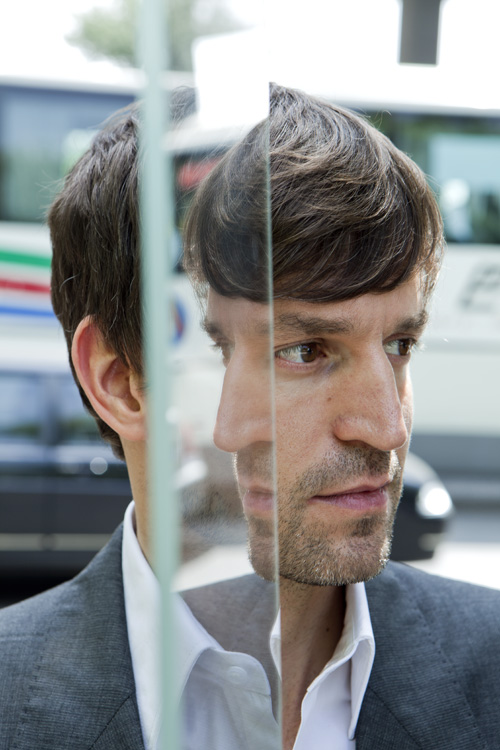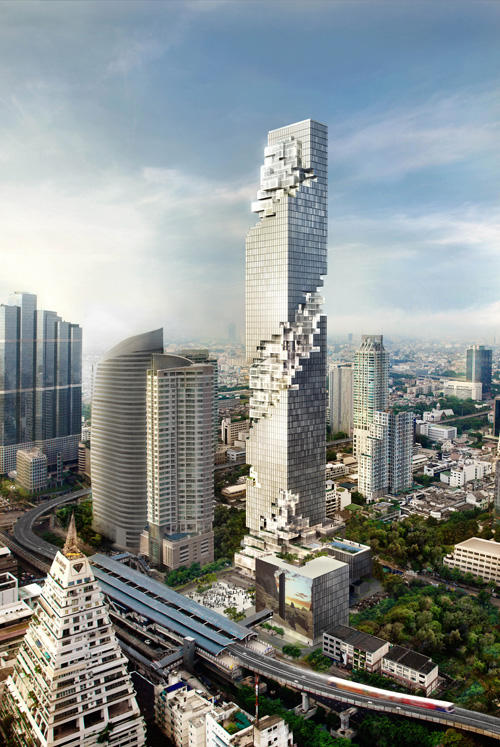Previous Article
Next Article
- AM WORLD
- FEATURES
- 100 YEARS OF ASTON MARTIN
- ARCHIVE
INTERVIEW
PACIFIC HEIGHTS
Beijing-based architect Ole Scheeren explains the inspiration behind his philosophy and where he sees the future of design.
Portraits: Wassink Lundgren at DMB Creatives.
Slide image »
A s an impressionable young backpacker, Ole Scheeren travelled to China in 1992 on a trip that, in his own words, “changed my life”. At the time, China was still fairly closed to tourism with access only available via group tours. On arrival, Scheeren changed his designated “tourist” currency to the local money via street vendors and ventured off the beaten path for three months by himself. “It deconstructed my limited European world view and upbringing. I was exposed to some very extreme conditions, like queuing for two-and-a-half days to buy a train ticket and sleeping in a workers’ dormitory with 200 people because there wasn’t a hotel in that city,” he recalls. “It was a huge challenge but a really liberating experience in terms of seeing and understanding that the world may function differently outside of a European cosmos.”
It seems that Scheeren has always exhibited a lively curiosity about the world and gravitated towards the unknown, embracing challenges and transforming them into meaningful encounters. Born to an architect father, he spent his formative years dismantling models “to see how I could put them back together again”. Initially, in an act of rebellion, he flirted with a career in music, playing in various bands, but realised it wasn’t an option: “I was too bad to gain anything meaningful out of it.”
After taking a varied path studying at the universities of Lausanne and Karlsruhe, Scheeren graduated from the Architectural Association School in London. He was awarded the RIBA Silver Medal and landed a place at the Office for Metropolitan Architecture (OMA) practice, co-founded by Dutch superstar architect Rem Koolhaas, where he rose swiftly through the ranks to become partner in 2002.

The impact of his first experience travelling around China had stayed with him, and in 2002, when OMA was invited to pitch to design the China Central Television (CCTV) Headquarters in Beijing, he jumped at the chance. “It was at a time when people in the office didn’t know much about China, I immediately suggested we should do it,” he remembers. OMA won the contract and, shortly after, Scheeren moved to Beijing to lead their largest-ever project. Did it frighten him taking on such huge responsibility at such a young age? “I could never afford to be because I think the moment that you are afraid, you weaken your position and start to make mistakes,” he replies. “Also, my youth was an advantage in terms of energy and focus, and I wasn’t stuck in a certain way of thinking, preventing me approaching things with an open mind.”
The fact that CCTV is nicknamed “big boxer shorts” by the locals is a testament to the unique aesthetic of the new building, which was unveiled last year. Set amid a Beijing skyline pierced by soaring towers of dizzying heights, this unique, glistening skyscraper is a breath of fresh air in the polluted landscape. Standing 234m tall, 44-storeys high, it takes the form of two adjoined high-rise towers: it is unlike any other skyscraper.
“When I started the project I realised that nothing similar had been done before—either in terms of that extreme scale nor at that complexity,” he says. “In a way, it was an impossible start but also liberating because there were no prototypes that existed. It meant that knowledge, in the classical sense, would no longer be applicable.”
Home to the state-owned CCTV, where editorial direction is subject to government policy considerations, it was inevitable taking on such a project would raise eyebrows. How did Scheeren feel about this? “It was something that we intensely debated among ourselves. What it would mean to build this in such a country for such a client and in such a context,” he says.
During this period, China was gaining economic momentum; it had just been accepted into the World Trade Organisation, Beijing had won the bid to host the Olympics and it seemed that a period of change and progress was imminent. Scheeren felt hopeful. “Our client was almost shockingly open about their own situation and this project was an important tool to advance an agenda change,” he says. “We felt that it was important to work in a country that had a context, which was so clearly focused on the future.”
In 2010, after 15 years at OMA, Scheeren left to set up his own practice, Büro-OS. Headquartered in Beijing, he is currently working on a series of projects across Asia including MahaNakhon, a 314m, 77-storey complex in Bangkok, which will be the tallest skyscraper in the city. Tallness for tallness’ sake, however, is never the primary focus of Scheeren’s work. He is more concerned with the way the buildings relate to their environment. “Typically a skyscraper is such a large entity that it becomes completely scaleless and stands as a more or less abstract totem; it no longer bears any indication of the life of the people inside. In a way, the building absorbs the life of the city.”
In order to address this for MahaNakhon, he has designed a pixellated ribbon of glass to reveal the human occupants inside. As a result, Scheeren explains: “The building starts to project back to the city the activity and life that it has absorbed itself. In that way, it will play an explicit role in shaping an aspect of public life.”
A further addition to his skyscraper portfolio is the DUO towers in Singapore, which explores the hypothesis that a building should not be a self-referential object, but a creator of urban space. “If you look at them in their plan, they are actually formed by spaces carved out of a theoretical building,” he says. “What happens is that the surrounding buildings symbiotically include them. I think that is quite a relevant position in general but in particular to Singapore where, if you look closer at buildings, they are typically very isolated and, in a way, there is no connective tissue between them.”

The DUO towers in Singapore explore the relationship between buildings and the space surrounding them
Other notable projects include Angkasa Raya, directly opposite the iconic Petronas Twin Towers in Kuala Lumpur. This high- rise skyscraper comprises of three “floating” tower blocks and two multi-level zones of open horizontal slabs that are autonomous yet connected in the way they appear to be stacked. Scheeren is also behind a large-scale residential project in Singapore, known as The Interlace, 1,040 apartments divided into 31 apartment blocks, each six storeys high, in a hexagonal arrangement around communal courtyards.
Among his skyscraper designs, Scheeren has also taken on a series of smaller commissions, many of which are art related. He enjoys the variety offered by working on different proportions: “While there is a certain fascination with the large scale and things you can do with it, there are completely different possibilities with a small-scale project,” he enthuses. “For example, to design a studio for a painter, you have to understand him personally as a character, his art and the way he works—and to create those spaces you have a completely different set of issues.” Despite being a Beijing resident for more than 10 years, Scheeren still finds working in the city thrilling. “I think it’s a sense that the future is not completely defined but an entity that requires constant redefinition. I think that commitment to the future is something that is incredibly exciting.”
With plans to open a London office, he voices a desire to draw on the experiences he has gained in Asia to pursue opportunities in the West. “It’s this hybrid position that I’m interested in—to be both an insider and outsider; an “insider means knowing how things work, what the sensitivities are, what the psychology of the place is, and an ‘outsider’ means that you can be more radical in terms of how you approach things and challenge the status quo.”

The futuristic Interlace development in Singapore–over 1,000 apartments in hexagonal shapes around communal courtyards
When it comes to differences in design principles between the East and the West, Scheeren believes that this lies in the psychology and society of a culture, and the way in which those two things interact. “It’s really about how people use spaces; what their intellectual, philosophical and pragmatic daily relationships are, and you try to understand those and give them the space to unfold,” he says. “In China, the blatant and simple difference is the scale. Here almost everything exceeds what would be thinkable in a European context.”
Working in a country whose power continues to grow at a startling pace, what are Scheeren’s thoughts on the future of architecture and design in China? “A continuous challenge that architects face is the battle between surface and meaning; image and content.
“We live at a time that is increasingly dominated by virtual reality and by images that seem to govern and dictate the way in which architects work,” he explains. “As a result, things are reduced to a singular image rather than understanding the complex challenges that a real building has to master.”
According to the architect, perhaps time is better invested in the more holistic aspects of the profession. “I think the challenge will be to not blindly follow the temptations of the different endless variety of shapes that can be produced by the tools we have at hand, but to really engage with the social and cultural responsibility that architecture carries.”
Scheeren has always been fearless in his approach to life, starting with that adventure as the young traveller who took to exploring a much less accessible China many years ago. Two decades on and not only has he had the chance to return but he has also made it his home and contributed to some of the greatest symbols of its growing economy.
“Twenty years ago, I never could have imagined my life to look how it does today, to have lived in so many countries, dealt with so many different cultures,” he says. “Maybe that is part of the secret; to be very open and to have the courage to confront yourself with continuously changing scenarios.”
Previous Article
Next Article
- AM WORLD
- FEATURES
- 100 YEARS OF ASTON MARTIN
- ARCHIVE
